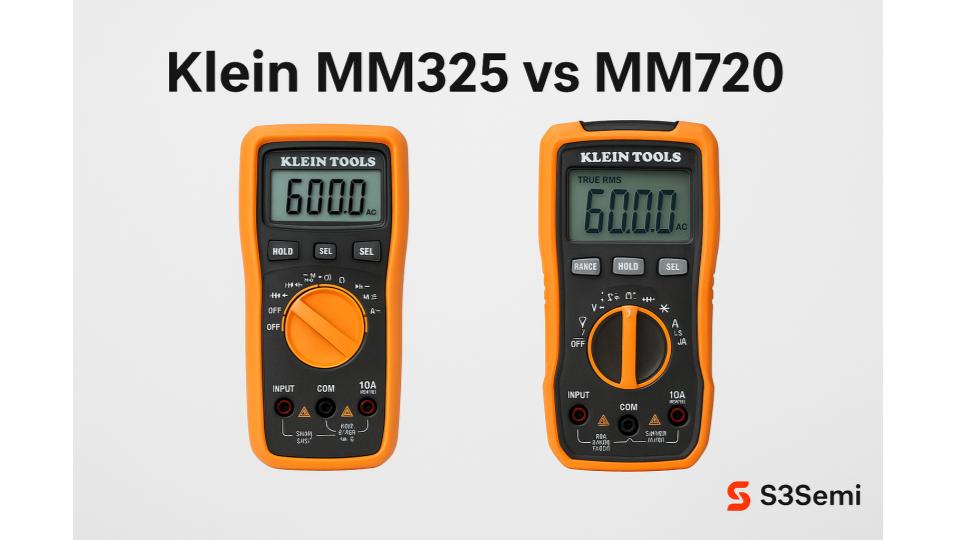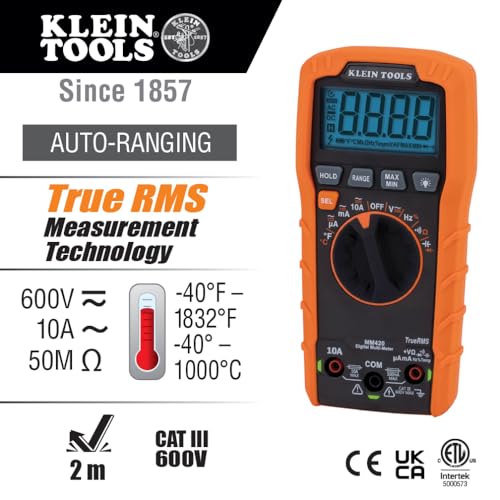If you’re shopping for a reliable multimeter from Klein Tools, two of their notable models are the MM325 and the MM720.
🏷️ Klein Multimeter Deals ⭐⭐⭐⭐
While they share the same brand reputation, they target different use cases and user expectations. Here’s a breakdown to help you decide which is right for your application.
📊 Specifications & Core Features
| Feature | Klein MM325 | Klein MM720 |
|---|---|---|
| Ranging style | Manual-ranging (you pick range) | Auto-ranging, true RMS |
| Voltage measurement | Up to 600 V AC / DC | Up to 1000 V AC / DC |
| Current (DC) | 10 A DC | 10 A (AC/DC) |
| Resistance range | Up to ~2 MΩ | Up to ~60 MΩ |
| Additional measurements | Continuity, diode test, battery testing | Temperature, low impedance mode, continuity, diode test |
| Safety / rating | CAT III 600 V | CAT III / CAT IV 1000 V (depending on model variant) |
| Use case target | Simpler general purpose, tradesman & residential tasks | Advanced, for pros who need broader range & TRMS accuracy |
| 💳 Pricing | 💲 Check Price | 💲 Check Price |
✅ Strengths & Ideal Use Cases
MM325
- Lower cost and simpler interface make it good for general tasks where you don’t always need high-end accuracy.
- Solid for electricians doing residential wiring, basic diagnostics, continuity, and voltage checks.
- Because it’s manual ranging, you have more control over range selection which some users prefer.
MM720
- Auto-ranging and true RMS make it more convenient and accurate, especially when measuring non-sinusoidal or distorted waveforms.
- Broad measurement range (up to 1000 V, 60 MΩ) gives more headroom for tougher jobs.
- Extra functions like temperature and low-impedance mode add versatility in industrial or HVAC environments.
- Better suited if you want one tool for many tasks rather than switching between meters.
⚠️ Weaknesses & Considerations
MM325:
- Manual range means you have to know approximate ranges, which can slow down workflow.
- Limited to 600 V — not ideal if you ever expect to measure higher voltages safely.
- No TRMS means readings may be less accurate when measuring distorted AC waveforms such as VFD outputs or noisy signals.
MM720:
- More features and higher performance often come with a higher cost.
- The display may be harder to read in bright light or tough conditions.
- Additional functions may go unused if you only need basic measurements.
🎯 Performance & Accuracy
The MM720’s true RMS measurement gives it a clear advantage when measuring AC signals that aren’t pure sine waves — such as PWM outputs, motors, or modern power supplies.
For straight DC voltage or simple AC sine signals, the MM325 is accurate enough for most tasks.
Both meters are built to handle professional environments, but the MM720’s precision and higher voltage tolerance make it more capable overall.
🛒 Buying Guidance
If you value budget and simplicity, go for the MM325. It’s a dependable, no-frills tool for routine electrical work.
If you prefer all-in-one versatility, the MM720 is the better choice. It offers broader measurement capability, higher accuracy, and convenience features for professional use.
Always ensure the meter’s safety category and design match your working environment.
In short:
- Choose MM325 if you want a solid, affordable meter for everyday tasks.
- Choose MM720 if you need a professional-grade multimeter with more range, precision, and safety features.





